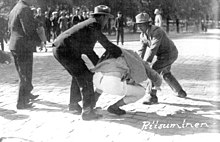User:Ta eis heauton/draftspace

The Lapua Movement (Finnish: Lapuan liike or lapuanliike, Swedish: Lapporörelsen) was a Finnish far-right radical nationalist and anti-communist political movement founded in and named after the town of Lapua in the Ostrobothnia region of Finland. At the height of its political power the movement used public pressure, political terror and violence to dictate both a change of government and an introduction of laws designed to ban all communist activity in the country.
The initial goal of anti-communism was widely supported across the political centre and right. After the banning of communism the movement targeted social democracy and its anti-democratic streak became evident. As a result the moderates abandoned the movement. The movement radicalized further towards far-right politics and was banned after the failed coup-d'état of Mäntsälä in 1932. The activity of the movement continued in the parliamentarian and openly fascist Patriotic People's Movement, which never managed to reach the influence Lapua Movement had at its height.
Background
[edit]The Lapua Movement started in 1929 and was initially dominated by anti-communist nationalists, emphasizing the legacy of the nationalist activism, the White Guards and the Civil War in Finland. The movement saw itself as the badly needed restorer of what was won in the Civil War, supporting Lutheranism, nationalism, and anti-communism.
Many politicians, and also high military officers, were initially sympathetic with the Lapua Movement, as anti-communism was the norm in the educated classes after the Civil War. However, excessive use of violence made the movement less popular within a few months.
In the Civil War Ostrobothnia was one of the most important strongholds and bases of the White army, and anti-Communist sentiments remained extremely strong in Ostrobothnia. Late in November 1929 the Young Communist League of Finland arranged agitation, meetings and protests in Ostrobothnian Lapua. As the Nationalists put it, the Communists had " mocked God, the Lutheran Church, the 'bourgeois' fatherland, the Finnish army and General Mannerheim".[1] This infuriated townspeople who violently made an end to the meeting. Anti-Communist violence was hailed as justified and praiseworthy. On December 1 the first anti-communist meeting was held, attracting more than 1,000 people demanding an end to all communist activities.
Activities
[edit]
Marches and meetings were arranged throughout the country. On June 16, 1930, more than 3,000 men arrived in Oulu in order to destroy the printing press and office of the Communist newspaper Pohjan Voima. However, the last issue of Pohjan Voima had appeared on June 14. The same day, a Communist printing press in Vaasa was destroyed. A so-called "Peasant March" to Helsinki was a major show of power. More than 12,000 men arrived in Helsinki on July 7. The government yielded under the pressure, and communist newspapers were outlawed in a "Protection of the Republic Act."
Meetings held by leftist and labour groups were also interrupted, often violently. More than 400 meeting locals owned by the labour movement were closed by Lapua activists.[citation needed]
One common treatment was "muilutus", which started with kidnapping and beating. After that the subject was thrown into a car and driven to the border of the Soviet Union. Tragically, many of the Finns deported by the Lapua Movement, and who remained in the Soviet Union, were later caught up in Stalin's Great Purge and executed; while persecuted in Finland as Communists, Stalin accused them of being "Nationalists".[2]
On October 14, 1930, the popular ex-president Kaarlo Juho Ståhlberg and his wife were kidnapped and driven to Joensuu (i.e., not really to the Soviet border this time). After this, general support for the movement collapsed. Moderate people left the movement, and extremists took the stage.
Failed rebellion
[edit]In February 1932 a Social Democrat meeting in Mäntsälä was violently interrupted by armed Lapua activists. The event escalated to an attempted coup d'état known as the Mäntsälä rebellion (Mäntsälän kapina), led by the former Chief of Staff of Finland's army, General Wallenius. Despite the appeals of Wallenius, the army and the White Guards were largely loyal to the government. Many historians believe the main reason for the failure was poor planning: the event just escalated from actions of the local chapter and the national organization came aboard later.[3] The rebellion ended after President Svinhufvud gave a radio speech to the rebels. After a trial, the Lapua Movement was banned on November 21, 1932, under the Protection of the Republic Act, which Lapua itself had worked to get passed. Wallenius and about 50 other leaders were sentenced to prison.
Legacy
[edit]After the Lapua Movement was banned, the Patriotic People's Movement was formed shortly thereafter. Like its predecessor, it also was nationalistic and anti-communist. It had limited political success and was banned in 1944 on the orders of the Soviet Union in the aftermath of the Continuation War.
See also
[edit]- Patriotic People's Movement (Finland)
- Politics of Finland
- History of Finland
- Vaps Movement (Estonia)
- Winter War
- Continuation War
- Heimosodat
References
[edit]- ^ (Niinistö, Jussi, Suomalaisia vapaustaistelijoita / Finnish Freedom Fighters, NIMOX KY/Ltd., 2003, pages 17–20; Siltala, Juha, Lapuan liike ja kyyditykset, Otava, 1985, pages 51–53; Virkkunen, Sakari, Suomen presidentit I / Finland's Presidents I, Otava, 1994, pages 192–193; Salokangas, Raimo, "Itsenäinen tasavalta" / "An Independent Republic," page 635 in Zetterberg, Seppo et al., eds., Suomen historian pikkujättiläinen / A Small Giant of the Finnish History, WSOY, 2003).
- ^ Iltalehti Teema Historia: Lapuan liike, Alma Media, 2015, p. 34-35.
- ^ Iltalehti Teema Historia: Lapuan liike, Alma Media, 2015, p. 4-7.
- Kirby, David (2006). A concise history of Finland. Cambridge University Press. ISBN 978-0-521-53989-0.
